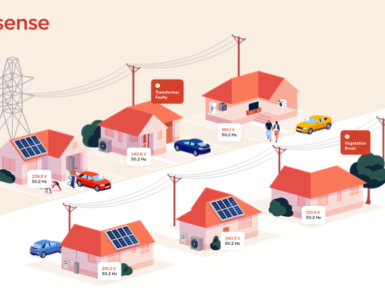Across Europe, governments, energy retailers, and consumers are seeking to reduce energy consumption. At the same time, there is a transition to cleaner energy sources, concern around energy scarcity and the various threats to national and international energy resources.
Technology is pivotal in answering this multifaceted challenge. For example, Advanced Metering Infrastructure (AMI) transforms how electric utilities access real-time, device-level data and realise smart grid functionality. Its impact extends across energy efficiency, demand response programmes, grid analytics, automation and sustainable energy.
Analysts predict the AMI market will be worth over $50bn by the end of 2030. The UK government has committed to a £14 billion nationwide AMI rollout. Analysts report its rise signals that such smart grid technologies will form backbone of the UK’s energy strategy.
With the power to reduce consumption, achieve grid resilience and avoid outages, all while supporting decarbonisation and energy efficiency, advanced metering infrastructure is a game-changer.
What is Advanced Metering Infrastructure, and how does it work?
Advanced Metering Infrastructure (AMI) is a cutting-edge solution revolutionising energy management. AMI provides real-time consumption insights across utilities, building communication networks that allow two-way communications between energy providers and end-users.
This means that AMI enables efficient and reliable delivery of energy while providing consumers with better insights into their energy usage. It is a crucial component of smart grid systems and an essential component of smart energy management.
For example, AMI allows electric utility providers to access energy consumption patterns as well as enable automated meter readings and richer data collection. These insights inform grid stability, load management, and demand response decisions. Importantly, providers can also get granular insight into outages, grid issues and maintenance needs.
AMI and smart metering
Next-gen smart meters – vital to effective energy management – rely on AMI.
For example, it is AMI functionality that enables technologies like Sense to deliver next-level energy consumption and energy management insights to both operators and consumers. While other AMI technologies may deliver consumption data at 15 or 30 minute intervals, Sense samples real-time, high resolution data at tens of thousands of times per second – 50 million times more data than 15-minute interval AMI data. In this way, Sense is unlocking the true value of AMI for consumers, retailers and operators, with next-level meter data management.
On the consumer end, this data is presented in user-friendly formats. With real-time data households gain unparalled insights into energy consumption, identifying energy-intensive activities. With this information decision making is informed and impactful. And, utilities, and policymakers now have accurate and immediate energy consumption data that they can use in a myriad of ways.
Five Benefits of Advanced Metering Infrastructure
1.Enhanced Energy Efficiency
With AMI, customers can access real-time consumption data via an app on their smartphones – enabling decision-making that truly impacts energy consumption and, in turn, reduces bills and eases budgets. Consumers get real-time visibility into energy usage and gain better control in their homes. For example, UK households using Sense can save 9% on their annual bill – about £300 on average.
Engaging customers directly, AMI promotes energy efficiency and sustainability. Households also have the tools to reduce energy consumption during peak hours when prices are highest. With AMI and technologies like Sense, that means they can make the most of two-way communication with retailers.
2. Successful Delivery of Demand Response programmes
AMI enables flexible energy strategies that impact the entire value chain. Effective data usage, powerful data management systems and communications technologies now deliver automatic meter readings and real-time insights that drive operational efficiencies, power utility and energy efficiency. For example, AMI systems enable electric utilities providers to activate demand response programmes easily.
Demand response is a smart strategy utilities providers use to manage electricity demand during peak times. When the demand for electricity surges, the strain on the grid can lead to inefficiencies, lower power quality and even grid outage. In demand response, consumers voluntarily adjust their energy usage when the demand for electricity is at its highest.
This adjustment can involve reducing or shifting non-essential electricity consumption to a later time when demand is lower. For example, encouraging electric vehicle owners to charge at low-demand times can have a huge impact on area networks. Such strategies can be combined with automation to ensure optimised power management – for example, the ability to turn Electric Vehicle charging on and off automatically in response to demand and pricing fluctuations.
Users are incentivised to engage with demand response programmes by being offered discounts and lower prices outside of peak times. But to ensure success energy providers must be able to effectively communicate with users. AMI networks power technologies, like Sense, that deliver real-time information on prices, incentives, and consumption behaviour. Alongside enabling distribution automation, this data helps to promote behaviour changes that support a sustainable energy future.
For example, when retailers ask homes without Sense to shift demand, an average of just 2-4% of peak consumption is typical. Our recent case study with OhmConnect demonstrated the impact of real-time consumer engagement; Sense householders lowered their home energy usage by 18%.
3. Added value and consumer engagement
The cost-of-living crisis means providers must offer added value. AMI promotes consumer engagement by empowering customers to drive down costs. Now, real-time data delivers personalised energy-saving tips and alerts. For energy utility providers, this is a game changer. For example, Sense’s app has 30x the engagement of utility customer engagement portals. What was once a one-sided relationship is now collaborative, engaged, and rewarding.
4. Grid resilience
By providing electric utilities and grid operators with real-time data on energy demand, supply, and usage, AMI improves grid resilience. It enables quick identification and response to grid disruptions and faults, reducing blackout risks.
Additionally, AMI helps manage distributed energy resources like solar panels and wind turbines. As renewable energy sources integrate into the grid, the need for real-time data and grid management grows.
5. Decarbonisation
AMI plays a pivotal role in decarbonisation. It promotes energy efficiency, enhanced demand response programmes, and supporting grid stability. AMI also enables renewable energy sources to be more easily integrated in a complex greener grid.
AMI vs AMR
Automated Meter Reading (AMR)
AMI is often talked about alongside Automated Meter Reading (AMR) systems but they are quite different. AMR collects energy consumption data from electricity meters at predetermined intervals. With periodic data transmission, the benefits of real-time insight cannot be realised. While both technologies involve automated data collection, AMI’s real-time functionality sets it apart.
Advanced Metering Infrastructure (AMI)
AMI is a system used by utility companies to remotely monitor, manage, and collect data from utility meters and represents a leap beyond AMR. Two-way communication enables continuous data exchange between consumers and utilities. The result is real-time granular insights for immediate energy management and automation.
Types of Meters Used in AMI
Various smart meters play a role in AMI. Each offers different levels of AMI data granularity and immediacy.
Ensuring the success of AMI; delivering the next-gen smart meter promise
Unfortunately, first-generation smart meters have not met their full potential and received a lacklustre response from many consumers. To reinvigorate consumer interest, the next roll-out phase must realise AMI’s potential at scale. To achieve this, energy stakeholders must consider several elements.
Firstly, seamless integration and interoperability are cornerstones of successful AMI implementation. The ability of smart meters and communication infrastructure to work harmoniously is essential. A cohesive and efficient data flow is vital. Similarly, the immediacy of data availability is fundamental to AMI’s efficacy. Ensuring that data is delivered and processed in true real-time is crucial for maximising AMI’s potential.
To achieve this, the UK’s next-generation smart meters must be specified appropriately. Embedding Sense intelligence into next-gen smart meters will future-proof the meter for decades to come. With a modest uplift in electric meter specification, it is possible to have a real-time localised view of the entire grid. And by shifting the focus to software, applications can be deployed without costly hardware upgrades.
The success of AMI also hinges on consumer education. Households must be aware of its benefits and offered easy ways to take part. That is why energy retailers must see AMI as a customer engagement strategy – a value-add for all.
Real-time smart meters; it makes Sense
The significance of AMI within the UK’s secure energy infrastructure cannot be overstated. Benefits extend beyond consumer empowerment and individual households. They address the most fundamental of energy challenges.
It is imperative that utility providers harness real-time data to make informed decisions. This includes grid load balancing, preventive maintenance, and essential demand response programmes. Policymakers, too benefit from comprehensive data analytics. Insight helps to craft energy-efficient policies and achieve sustainability objectives.
As we have explored, AMI technology paves the way for smarter, more informed energy strategies. AMI has emerged as a game-changer and utility companies who embrace it now will reap the many rewards.







